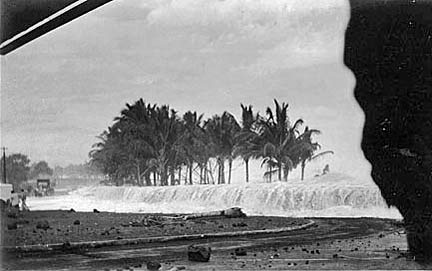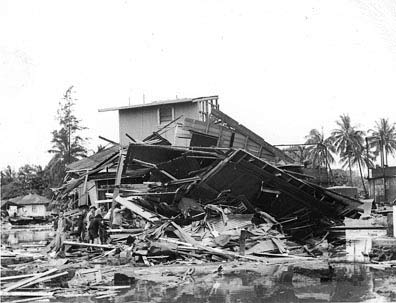
A wave washes over a 6-foot high wall during the 1946 tsunami in Hilo.
‘So this is how
it feels to die’
Survivors of the wave that
barreled into Hilo in 1946 are
part of an anniversary event
HILO » Seven-year-old Joan Yamamoto realized her foot was caught by a board as her house started to fall apart under a massive wall of water. She was knocked under water, came up for a breath, then went under again.
TSUNAMI-RELATED EVENTS
April is Tsunami Awareness Month in Hawaii. The following events are planned this year:
» Today: annual reunion of Shinmachi (Hilo) survivors of 1946, 10:30 a.m., Wailoa State Park
|
"I just thought, 'So this is how it feels to die.'"
Fifty-nine years after the April Fool's Day tsunami of 1946 killed 159 people in Hawaii, a series of events is planned to observe the anniversary and to prepare for future tsunamis.
Many of these events take place annually, such as the statewide preparedness exercise on Friday, which state Civil Defense holds twice a year.
But following the Dec. 26 tsunami in the Indian Ocean that killed more than 250,000 people, a lot more people are willing to pay attention to preparedness now, said Civil Defense spokesman Ray Lovell.
Boaters in particular will be the focus of the April 1 preparedness exercise this year, he said. The intent is to persuade yacht owners to go to high ground during a tsunami alert rather than contribute to a boating traffic jam as well as an automobile traffic jam with the cars they leave behind while trying to get out of harbors.
Hotels and resorts will also test their preparedness for "vertical evacuation," simulating plans to get guests to the hotel's third floor without a human traffic jam on stairways and in elevators.
In 1946, in the shoreline area of Hilo known as Shinmachi, no one was prepared. No warning told residents a tsunami was sweeping down from the Aleutian Islands of Alaska.
Moments before 7 a.m., Joan Yamamoto, now Joan Shaw, looked out her window with her mother and six brothers and sisters. They had a clear view of Hilo Bay.
"It was an awesome thing. You could see sand on the whole bottom of the bay," Shaw said.
Shaw saw the water sweep back in, glimpsed the apartment building next door crack open, furniture tumbling out, then found herself in water with her foot caught.
Her mother pulled her loose, tearing a flap of skin the length of her foot, creating a scar that lasts to this day. A brother and a sister died in the flood.
"For a long, long time, I couldn't even talk about it," she said.
Donald Ikeda, now a Hawaii County Councilman, was 5 at the time. "I had nightmares for the longest time," he said.

In 1946, in the shoreline area of Hilo known as Shinmachi, no one was prepared for the tsunami that swept down from the Aleutian Islands of Alaska. This picture shows some of the destruction that the tsunami caused.
His mother ordered him out of the house through a window onto a roof.
"I saw people killed," he said. Among the tightly packed houses of Shinmachi, he saw a couple in their 40s on their roof 15 feet away, calling for help. "The water just knocked the house down like match sticks," he said. The couple disappeared.
References to tsunami waves suggest large but nicely shaped formations, Ikeda said. "It's nothing like that."
The churning wall of water full of debris means that it's nothing like a surfer's dream wave, said Lovell at Civil Defense. The agency issued a video last year called "You can't surf a tsunami." In 1994, during the state's last tsunami alert, some 400 surfers went into the water hoping to do just that.
Besides this year's message, that you can't hope to get hundreds of boats out of Ala Wai Yacht Harbor before the wave hits, Civil Defense is hoping to teach people to evacuate on their feet.
Officials will be able to provide at least three hours warning for a tsunami generated outside Hawaii. "Just walk," Lovell said. "If you get in your car, you may be stuck."
The potential for a tsunami warning system was in place as early as 1923. Thomas A. Jaggar, director of the Hawaiian Volcano Observatory, noticed seismograph recordings on Feb. 3 of that year that suggested an earthquake in the far north Pacific might have generated a tsunami.
He called the Hilo harbormaster and warned him, but the warning was ignored, according to the book "Tsunami!" by University of Hawaii at Hilo professor Walter Dudley and co-author Min Lee. Statewide, there was one death and $1.5 million damage in 1929 dollars, or about $17 million in today's money.
Two other seismologists gave warnings of an earthquake off Japan in 1933. No lives were lost and damage was small.
A true warning system was put into place about 1949. In more than five decades since then, a Pacific system has been created that includes more than 100 water-level gauges on the surface of the sea and six tsunami pressure detectors on the sea floor, five in the Alaska and Washington areas, and one south of Hawaii facing Chile.
Since the Dec. 26 Indian Ocean earthquake, the federal government is planning to spend $37.5 million for 32 more ocean-floor tsunami detection systems, most in the Pacific, but some also in the Atlantic and Caribbean, according to a White House fact sheet.
Meanwhile, 46 countries, including 21 facing the Indian Ocean, sent delegates to a six-day conference in Paris early this month to discuss ways of setting up an Indian Ocean tsunami warning system.
The intent is for each country to set up its own system, but for all of them to cooperate, says a UNESCO report.
But a warning system isn't enough, says Big Island Mayor Harry Kim, Hawaii County's former Civil Defense director. Even if they get a warning, many jurisdictions on the West Coast have no plan for how to respond to it, he said.
Councilman Ikeda remembered the 1960 tsunami in which 61 people died in Hawaii and $23 million in damage took place. Some people went home to their death after the initial evacuation. "The (warning) system worked perfectly. It was people's attitudes that needed tuning up," Ikeda said.
PBS's 'Nova' to air show
|
[News] [Business] [Features] [Sports] [Editorial] [Do It Electric!]
[Classified Ads] [Search] [Subscribe] [Info] [Letter to Editor]
[Feedback]
